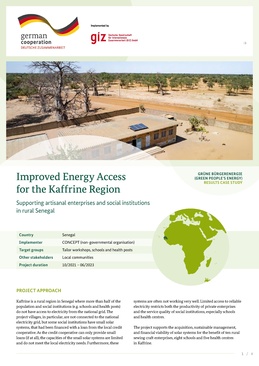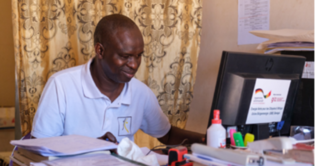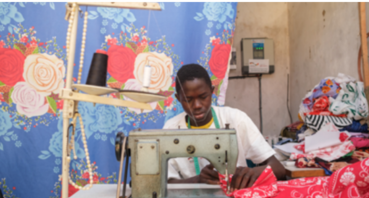Knowledge fuels change - Support energypedia!
For over 10 years, energypedia has been connecting energy experts around the world — helping them share knowledge, learn from each other, and accelerate the global energy transition.
Today, we ask for your support to keep this platform free and accessible to all.
Even a small contribution makes a big difference! If just 10–20% of our 60,000+ monthly visitors donated the equivalent of a cup of coffee — €5 — Energypedia would be fully funded for a whole year.
Is the knowledge you’ve gained through Energypedia this year worth €5 or more?
Your donation keeps the platform running, helps us create new knowledge products, and contributes directly to achieving SDG 7.
Thank you for your support, your donation, big or small, truly matters!
Improved Energy Access for the Kaffrine Region in Senegal
Improved Energy Access for the Kaffrine Region in Senegal
Project Approach
Kaffrine is a rural region in Senegal where more than half of the population and social institutions (e.g. schools and health posts) do not have access to electricity from the national grid. The project villages, in particular, are not connected to the national electricity grid, but some social institutions have small solar systems, that had been financed with a loan from the local credit cooperative. As the credit cooperative can only provide small loans (if at all), the capacities of the small solar systems are limited and do not meet the local electricity needs. Furthermore, these systems are often not working very well. Limited access to reliable electricity restricts both the productivity of private enterprises and the service quality of social institutions, especially school and health centres.The project supports the acquisition, sustainable management, and financial viability of solar systems for the benefit of ten rural sewing craft enterprises, eight schools and five health centres in Kaffrine. An initial technical assessment showed that the best solution is to install battery-powered solar systems on the rooftops of the workshops, schools, and health centres. These systems provide the sewing enterprises and social institutions with a steady supply of electricity. Apart from the technical installations, the approach comprises of four components: technical training, coaching, promotion of best practices, and dialogue between the suppliers of solar energy systems and end-users, small businesses and social institutions. Capacity building on technical issues related to the solar systems is offered to tailors, school directors and health centre managers in order to facilitate the sustainable use and maintenance of the systems. In addition, the tailors are supported in identifying and coaching profitable business models for the sewing enterprises.
The Green People’s Energy (Grüne Bürgerenergie, GBE) project is primarily responsible for supervising the technical advice, design and installation of the solar systems as well as supervising all other operations. CONCEPT is in particular responsible for the dialogue with the beneficiaries, the technical dimensioning and installation of the solar systems as well as for the skills development of the beneficiaries in the four components mentioned above.
Methodology of Data Collection
The data for this case study report was collected through a review of project documents, five qualitative interviews with representatives of GIZ, the implementing non-governmental organisation (NGO) CONCEPT, local beneficiaries such as tailors, nurses and headmasters, and quantitative surveys (staff from two health centres, four tailor workshops and two schools participated in the surveys). The case study was conducted between March and May 2023, with some project activities still ongoing. Therefore, the impacts cannot be fully captured at this point.
Key Findings
Project Achievements
The new solar systems with a total capacity of around 30 kWp and battery storage provide the sewing companies and the social institutions with cheap, sufficient and uninterrupted electricity day and night. This permanent electricity supply ensures that the local electricity needs are met. It benefits around 1.500 pupils and teachers, the catchment area of the health centers with approximately 6,500 people and 10 tailor workshops.
In addition, the project’s contribution to improving the enabling environment for renewable energy – and solar energy in particular – in Kaffrine is noteworthy. It brought together suppliers and users of solar systems, local politicians, NGOs and financial institutions, and started a dialogue to exchange views and explore ways of sustainably financing renewable energy installations.
Intermediate Impact
In particular for those social institutions and enterprises that participated in the quantitative surveys, numerous diverse positive impacts are evidently existent.The solar systems with solar panels, LED lamps and batteries have brought electric light to businesses and institutions, bringing further development benefits in terms of education, health and business opportunities. Pupils and teachers, as well as tailors and nurses can work longer hours. Teachers can extend parent-teacher meetings into the night. Improved lighting in schools also means that pupils can stay in school longer, e.g. to do their homework.Schools now have electrical outlets that allow them to use personal computers and printers purchased by the project. Teachers can print out study materials for pupils to take home, improving the quality of their education and ultimately their chances of getting better jobs.In addition, teachers are more motivated and satisfied, as they can both give better lessons and use the electricity for private purposes such as smartphone charging.
The nurses in the health centres use the energy generated by the solar system more than five days a week to light and cool their rooms with fans. With sufficient light, they can now examine patients and even perform minor surgeries at night. As one nurse recounted: “We only had a torch at night and couldn‘t even propperly illuminate our patient rooms with it, for example to see if animals like small snakes have gotten into the rooms. That‘s over now. Thanks to the electric light, we can see any ‘uninvited guests’ at night and take action against them.” With the availability of light, the number of examinations, treatments and operations has increased significantly. One of the health centres has expanded its range of services. Certain types of operations can now be carried out that were not possible before. The same holds true for disease prevention – health centres can now offer vaccinations that couldn’t be offered before. Vaccines can be stored in the refrigerator for longer periods, and the overall number of vaccinations has increased in at least one of the health posts. Nurses are now also able to use both ultrasound devices as well as neonatal incubators to reanimate newborn babies – all at the same time. Previously, there was only enough power for one or the other. These measures improve the health of the rural population, especially that of pregnant women. Neonatal mortality has been reduced; even the total number of babies dying has decreased. Babies can now be weighed right away on an electric scale, of which one nurse says: “We have purchased the scale some time ago but were only able to use it sporadically. Now, we can use it every day for weighing the newly born children.”
While one health centre has even officially extended its opening hours, it is now possible to attend to emergencies also during the off-hours or when there is little daylight. Patients who arrive after dark are not sent home, but either receive immediate treatment or can be hospitalized overnight. Electric fans make hospital stays more comfortable by lowering the temperature in patients’ rooms – and they also drive out the flies. This has increased the number of people accommodated – both patients and relatives. As more advanced operations can be performed locally, fewer patients have to undertake the trip to the city. As these surgeries are more profitable, the economic viability of health centres has improved. Additional income can be reinvested in the quality of the medical equipment and hospital infrastructure. Due to the fact that also nurses’ working conditions have improved, nurses who were considering leaving the rural health centres for the (better equipped) urban health centres are now staying.Supported tailors are also more productive now that they can extend their working hours into the dark. They have started to work on new products and most of them are recognising increased sales, turnover, and ultimately, income.As well as learning about the solar systems, the tailors received training in business management. In coaching sessions, they developed new business models, which they shared with other tailors. From the start of the project until today, there has been a regular exchange between the tailors. The dialogue initiated by the project between the target groups of schools and tailors has led to a new market for the tailors: they are now working together to sew blouses as part of the school uniforms. This is possible as tailors can now use electric sewing machines instead of mechanical pedal sewing machines. Previously, tailors could only use their electric sewing machines with grid power in the city, but not in the rural areas where they work. With the new technical capabilities, individual tailors are now also introducing new techniques such as embroidery. This is a good example of sustainable productivity gains through electrification.
Climate Impact
Following the calculation methodology of the United Nations Framework Convention on Climate Change (UNFCCC), the installations described above are estimated to mitigate 36,11 t CO2 e/a in the year of installation by avoiding the use of fossil fuels. This is roughly equivalent to the annual CO2 emissions of more than 25 medium-sized cars in Germany.
Challenges in Project Implementation
No implementation challenges were identified by the interviewees and survey respondents. Interviewees were satisfied with the speed at which the solar systems were installed, the content of the training and coaching provided by GBE, and the design and construction of the solar installations that were carried out by GBE.
Lessons Learned
The project was very successful due to a regionally focussed approach with a clear, straightforward but holistic and participatory project design and specific (albeit small) target groups.Furthermore, the allocation of responsibilities and the communication between CONCEPT and GBE worked very well. Also, the selection of the beneficiaries was done successfully in close cooperation between the two organisations. Another important success factor was the networking of the beneficiaries involved and the combination of renewable energy installations with vocational training.
Sustainability of the Intervention
At the time of the study, the installed solar systems were still fully functional. The health centres and schools interviewed did not report any maintenance or repair problems with the systems. The risk that technical challenges will reduce benefits in the future has been reduced through user training, and technological development has improved the longevity of the systems. Nevertheless, they will have to be replaced one day, and saving up for that day may need to start early. As a result of the project’s success and the new operational/production and learning opportunities, the beneficiaries are already thinking about how to increase their solar capacity. Furthermore, they spread the word: enthusiastic about the benefits of the solar energy in their health centres, the nurses have recommended the solar technology to other facilities. These are interested to learn more about the solar system, as confirmed by the survey. The same holds true for the other two target groups.
Conclusion and Outlook
Overall, it can be concluded that the project approach was appropriate to reach the objectives and the target groups. The project demonstrates that a relatively low-budget project can lead to intensive improvements in the living conditions and financial performance of different groups: tailors, health centre nurses as well as teachers, parents, and pupils in schools. The individual components of solar installations and business training complemented each other well. New alliances have been formed, such as tailors and schools working together to produce school uniforms.
In principle, the project can be replicated with other target groups, e.g. other crafts and trades, and in other off-grid rural areas, where access to solar systems can make a huge difference to economic and social development. However, scale-up is not automatic – given the rural disadvantages in access to knowledge, hardware and maintenance services, it is unlikely that more villages will be able to adopt the models without additional support. International and national projects are necessary to fund solar electrification projects in the rural areas of Senegal and elsewhere where rural access to electricity is lacking. Projects should continue to encourage local and national governments to invest more money in solar systems for social institutions such as health centres, schools and community centres – their potential to improve the lives of people in rural areas is enormous in terms of health, education and income possibilities. In this way, more people can be encouraged to stay in rural areas and migration can be reduced, keeping rural communities vibrant and liveable.






















